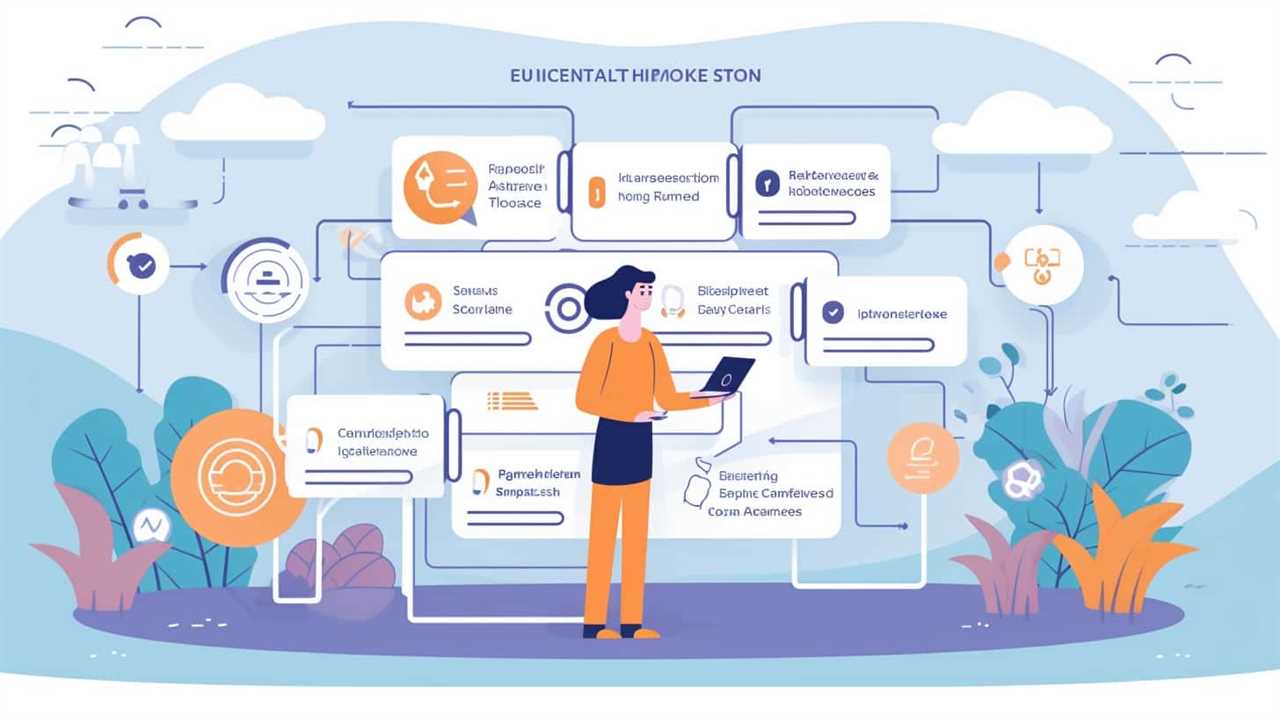Are you looking to boost your presence locally? We have exactly what you’re searching for!
In this article, we’ll reveal 15 mobile SEO tactics that will revolutionize your online presence.
From optimizing your website’s mobile design to implementing responsive web design and improving loading speed, we’ll show you how to make your site mobile-friendly and attract more local customers.
Get ready to unlock the secrets of mobile SEO and dominate your local market!

Key Takeaways
- Use responsive web design techniques to ensure seamless adaptation to different screen sizes and devices.
- Incorporate mobile design trends and user behaviors to engage and convert the mobile audience.
- Prioritize mobile optimization to effectively reach the local audience.
- Implement click-to-call and directions features for local businesses to improve local visibility.
Optimize Your Website’s Mobile Design
To optimize our website’s mobile design, we can use responsive web design techniques, ensuring that it adapts seamlessly to different screen sizes and devices. With the ever-changing mobile design trends and the evolving mobile user behavior, it’s crucial for businesses to stay ahead in the game.
Mobile users have specific preferences and behaviors when it comes to browsing websites on their devices. By implementing a responsive design, we can provide a user-friendly experience that caters to their needs. This includes designing mobile-friendly layouts, optimizing images and content for faster load times, and ensuring easy navigation with clear call-to-action buttons.
By understanding and incorporating these mobile design trends and user behaviors, we can create a website that engages and converts our mobile audience.
Now, let’s move on to the next section and discuss how to implement responsive web design effectively.

Implement Responsive Web Design
Implementing responsive web design is crucial for optimizing your website for mobile devices. By ensuring that your website adapts seamlessly to different screen sizes, you can provide a positive user experience for mobile users.
This not only improves your mobile SEO, but also increases the chances of attracting and retaining local customers.
Importance of Mobile Optimization
We need to prioritize mobile optimization by incorporating responsive web design into our strategy. With the increasing use of smartphones and tablets, mobile optimization has become crucial for businesses to reach their local audience effectively. Here are three reasons why mobile optimization is important:
- Improved user experience: Responsive web design ensures that your website adapts seamlessly to different screen sizes, providing a user-friendly experience. This leads to higher engagement and longer time spent on your site.
- Higher search rankings: Google prioritizes mobile-friendly websites in search results, especially for local searches. By optimizing your site for mobile devices, you can improve your visibility and attract more local traffic.
- Increased conversions: A mobile-optimized website makes it easier for users to navigate, find information, and complete actions such as making a purchase or submitting a contact form. This can significantly boost your conversion rates.
User Experience Optimization
One important aspect of optimizing user experience is incorporating responsive web design into our strategy. Responsive web design ensures that our website adapts and functions seamlessly across different devices, providing a consistent and user-friendly experience. This is crucial for user engagement and improving the mobile conversion rate.

By implementing responsive web design, we can eliminate the need for users to pinch, zoom, or scroll excessively to view our content. Instead, the website automatically adjusts its layout and design to fit the screen size of the device being used. This not only enhances user experience but also makes it easier for users to navigate our website and find the information they need.
In the next section, we’ll explore another important factor in optimizing user experience: improving website loading speed.
Improve Website Loading Speed
Improving website loading speed is crucial for a better user experience and higher search engine rankings.
By utilizing image compression techniques, we can reduce the file size of images without sacrificing quality, resulting in faster loading times.

Additionally, caching and minification can help optimize website performance by storing and delivering content more efficiently.
Image Compression Techniques
Using effective image compression techniques is essential for improving website loading speed. When it comes to image optimization, reducing the mobile image size is crucial. Here are three techniques that can help you compress your images and enhance your website’s performance:
- Resize images: Use responsive design to adjust the image dimensions based on the user’s device. This ensures that the image is displayed properly without wasting bandwidth.
- Compress images: Utilize tools like JPEG Optimizer or PNGGauntlet to reduce file sizes without sacrificing image quality. These tools remove unnecessary metadata and compress the image to a smaller size.
- Lazy loading: Implement lazy loading to load images only when they’re visible on the user’s screen. This technique significantly improves page loading time, especially for websites with numerous images.
Caching and Minification
How can we enhance website loading speed and improve user experience through caching and minification?
Caching optimization and code minification are two powerful techniques that can significantly improve website loading speed and enhance user experience.

Caching optimization involves storing frequently accessed website data in temporary storage, allowing for faster retrieval and reducing the need for repeated data fetching. This can be achieved through browser caching, server-side caching, and content delivery network (CDN) caching. By leveraging caching, websites can deliver content more efficiently, resulting in faster load times.
Code minification, on the other hand, involves removing unnecessary characters, spaces, and line breaks from the website’s code. This reduces the file size and eliminates any redundant code, resulting in faster loading times. Additionally, minified code is easier for search engine crawlers to read, leading to better search engine optimization (SEO) performance.
By implementing caching optimization and code minification techniques, websites can significantly improve loading speed, resulting in a better user experience.
In the next section, we’ll explore the importance of using mobile-friendly navigation menus.

Use Mobile-Friendly Navigation Menus
We have found that implementing mobile-friendly navigation menus significantly enhances the user experience on mobile devices. Mobile SEO benefits are maximized when users can easily navigate through a website on their mobile devices.
Here are some mobile navigation best practices to consider:
- Keep it simple: Use a clean and minimalistic design with clear labels and easy-to-tap buttons.
- Prioritize important content: Place the most important pages or sections at the top of the menu for easy access.
- Use responsive design: Ensure that the navigation menu adjusts seamlessly to different screen sizes and orientations.
Optimize Content for Mobile Devices
When it comes to optimizing content for mobile devices, responsive design is of utmost importance. It ensures that your website adapts to different screen sizes and provides a seamless user experience.
Responsive Design Importance
Responsive design is essential for optimizing content on mobile devices. With the increasing number of people accessing the internet through their smartphones and tablets, it’s crucial to ensure that your website is responsive and adapts to different screen sizes. Here are some key benefits of responsive design:

- Improved user experience: Responsive design provides a seamless browsing experience for users on mobile devices. It eliminates the need for zooming and scrolling, making it easier for users to navigate and interact with your website.
- Higher search engine rankings: Google prioritizes mobile-friendly websites in its search results. By implementing responsive design, you increase the chances of your website ranking higher in search engine results pages.
- Future-proofing your website: With the impact of mobile-first indexing, responsive design becomes even more important. It ensures that your website is ready for the future, as search engines increasingly prioritize mobile-friendly content.
Mobile-Friendly Website Benefits
How can optimizing content for mobile devices benefit our local reach?
Mobile-friendly website design and mobile optimization offer numerous benefits that can greatly enhance our local reach.
Firstly, a mobile-friendly website ensures that our content is accessible and user-friendly on mobile devices, which is crucial considering the growing number of mobile users. This improves the overall user experience and encourages users to stay longer on our site, increasing the likelihood of conversions and engagement.
Secondly, mobile optimization boosts our website’s visibility in search engine rankings, as search engines prioritize mobile-friendly sites in mobile search results. This can lead to higher organic traffic and visibility for our local business.

Lastly, a mobile-friendly website can help us establish credibility and trust with our audience, as it demonstrates our commitment to providing a seamless experience across all devices.
Utilize Local Keywords in Your Website’s Content
To maximize your website’s visibility in local search results, incorporate relevant local keywords into your website’s content. Local keyword research is crucial in identifying the specific terms and phrases that your target audience uses when searching for local businesses or services. By utilizing these keywords strategically in your website’s content, you can increase your chances of ranking higher in local search results.
Here are three important strategies for local content optimization:
- Location-specific landing pages: Create dedicated landing pages for each location you serve, optimizing them with local keywords and providing valuable information about your products or services in that area.
- Include location in page titles and headings: Incorporate the name of your city or region in your page titles, headings, and meta descriptions to signal to search engines that you’re targeting a specific location.
- User-generated content: Encourage customers to leave reviews and testimonials that include local keywords, as this can boost your website’s visibility and credibility in local searches.
Optimize Meta Tags for Local Searches
When it comes to optimizing our website for local searches, one important aspect that we mustn’t overlook is the optimization of meta tags.

Meta tags provide search engines with important information about our web pages, helping them understand the context and relevance of our content.
By including relevant local keywords in our meta tags, we can improve our chances of ranking higher in mobile search results and increasing our local reach.
Local Meta Tag Optimization
One important tactic for improving local reach in mobile SEO is optimizing meta tags specifically for local searches. Meta tags provide information about a webpage to search engines and users.
When it comes to local meta tag optimization, there are several key strategies to consider:

- Include location-specific keywords: Incorporate relevant keywords that are specific to your local area in the meta tags. This helps search engines understand the local relevance of your content.
- Optimize title tags: Craft compelling and keyword-rich title tags that not only describe your content but also include your location. This can improve your visibility in local search results.
- Utilize local schema markup: Implement schema markup on your website to provide search engines with structured data about your business, including your address, phone number, and operating hours.
By implementing these local meta tag optimization tactics, you can increase your chances of appearing in local search results and attract more targeted traffic to your website.
Now, let’s delve into the next section about mobile search rankings and how they can impact your local reach.
Mobile Search Rankings
Now that we have explored the importance of local meta tag optimization, let’s delve into how mobile search rankings can be improved by optimizing meta tags for local searches. Mobile search algorithms and trends are constantly evolving, and it is crucial to stay ahead of the game to maximize your local reach. By optimizing your meta tags for local searches, you can greatly improve your mobile search rankings and increase your visibility to potential customers in your area.
To help you understand the impact of meta tag optimization on mobile search rankings, here is a table showcasing three key elements to consider:

| Meta Tag Element | Importance for Mobile Search Rankings |
|---|---|
| Title Tag | Plays a significant role in mobile search rankings and should include relevant keywords and location information. |
| Meta Description | Provides a concise summary of your page content and should be optimized with relevant keywords and a call-to-action. |
| Header Tags (H1, H2, etc.) | Help search engines understand the structure of your content and should include relevant keywords and location information. |
Claim and Optimize Your Google My Business Listing
To effectively expand our local reach, we must first claim and optimize our Google My Business listing. This is an essential step in improving our online visibility and attracting more local customers.
Here are three key benefits of claiming and optimizing our Google My Business listing:
- Increased online visibility: By claiming our listing, we ensure that our business appears on Google Maps and in local search results. This makes it easier for potential customers to find us when they’re searching for products or services like ours in our area.
- Enhanced credibility and trust: A well-optimized Google My Business listing adds credibility to our business. It displays important information such as our address, phone number, and customer reviews, which helps potential customers trust and choose us over competitors.
- Better customer engagement: With a claimed and optimized Google My Business listing, we can engage with customers by responding to their reviews, answering their questions, and providing timely updates about our business. This helps build a strong relationship with our local audience and encourages them to choose us.
Encourage Online Reviews and Ratings From Local Customers
After claiming and optimizing our Google My Business listing, the next step is to actively encourage online reviews and ratings from our local customers. Online reviews and ratings play a crucial role in shaping our online reputation and influencing potential customers. Positive reviews can attract new customers, while negative reviews can deter them. Therefore, it is essential to implement effective strategies for online reputation management and customer feedback analysis.
To encourage online reviews and ratings, we can follow these tactics:

| Tactics | Benefits |
|---|---|
| Offer incentives | Encourages customers to leave reviews |
| Make it easy to leave reviews | Increases the likelihood of participation |
| Respond to reviews | Shows that we value customer feedback |
| Share positive reviews | Builds trust and credibility |
| Address negative reviews | Demonstrates commitment to customer satisfaction |
Create Location-Specific Landing Pages
One effective tactic for improving our mobile SEO and expanding our local reach is to create location-specific landing pages. By tailoring our landing pages to specific locations, we can better target our audience and increase our visibility in local search results.
Here are three strategies for creating effective location-specific landing pages:
- Location-based targeting: Utilize location-based keywords and phrases in your landing page content to optimize it for local searches. This will help search engines understand the relevance of your page to specific locations.
- Geolocation strategies: Use geolocation technology to automatically detect a user’s location and provide them with customized content on your landing page. This can include personalized offers, relevant local information, and targeted calls-to-action.
- Local testimonials and reviews: Incorporate testimonials and reviews from local customers on your landing pages. This adds credibility and trustworthiness to your business, making it more appealing to potential customers in the area.
Implement Schema Markup for Local Business Information
By incorporating schema markup for local business information, we can enhance the visibility and relevance of our mobile SEO efforts to potential customers in the area.
Schema markup is a structured data markup language that helps search engines understand the context and meaning of our content.

When applied to local business information, schema markup provides a range of benefits for local business SEO. It allows search engines to display rich snippets in search results, providing users with valuable information such as business hours, customer reviews, and contact details.
This not only improves our visibility in search results but also increases our credibility and click-through rates.
Schema markup also helps search engines understand our website’s geographic location, making it easier for them to connect us with local search queries.
Optimize Your Website for Voice Search
To enhance our mobile SEO efforts for local reach, we can optimize our website for voice search through the use of a compound preposition. Voice search optimization is crucial in today’s digital landscape, as more and more users are using voice commands to find local businesses.

Here are three strategies to optimize your website for voice search:
- Focus on long-tail keywords: Voice search queries tend to be longer and more conversational. Incorporate natural-sounding phrases and questions into your content to match user intent.
- Optimize for local search: Voice search often includes location-based queries. Make sure your website is optimized for local SEO by including your business address, phone number, and relevant local keywords.
- Improve website speed and mobile responsiveness: Voice search users expect quick and accurate results. Ensure your website is mobile-friendly and loads quickly to provide a seamless user experience.
Utilize Mobile-Friendly Pop-Ups and Interstitials
Utilizing mobile-friendly pop-ups and interstitials can greatly enhance our mobile SEO efforts for local reach. Mobile ad targeting is a key component of mobile SEO best practices, and incorporating mobile-friendly pop-ups and interstitials into our strategy can help us effectively target our local audience.
These interactive elements can be used to engage users, capture their attention, and drive them to take desired actions, such as signing up for newsletters or making a purchase. However, it’s important to ensure that these pop-ups and interstitials are optimized for mobile devices, as they can negatively impact user experience if not implemented correctly.
Optimize Your Website for Mobile Search Intent
To further enhance our mobile SEO efforts for local reach, it’s crucial to optimize our website for mobile search intent. Mobile search trends indicate that more and more users are turning to their smartphones for information, making it essential for businesses to adapt their websites accordingly.

Here are some mobile search optimization techniques to consider:
- Ensure your website is mobile-friendly and responsive, with a clean and user-friendly design that adapts well to different screen sizes.
- Optimize your website’s loading speed to provide a seamless browsing experience for mobile users.
- Implement structured data markup to enhance search engine visibility and improve the way your website appears in mobile search results.
By implementing these techniques, you can align your website with mobile search intent and improve your chances of ranking higher in mobile search results.
Now, let’s move on to the next section and explore how to monitor and analyze your mobile SEO performance.
Monitor and Analyze Your Mobile SEO Performance
Now let’s delve into how we can effectively monitor and analyze our mobile SEO performance to ensure optimal results for our local reach.

Mobile SEO analysis is crucial for understanding how well our website performs on mobile devices and identifying areas for improvement. By tracking mobile SEO performance, we can gather valuable insights into our website’s visibility, organic traffic, and user engagement on mobile devices.
Tools like Google Analytics and Google Search Console offer essential data on mobile-specific metrics such as mobile organic traffic, bounce rate, and average session duration. Additionally, we can use mobile-friendly testing tools to ensure that our website is optimized for mobile search intent.
Regularly monitoring and analyzing our mobile SEO performance will enable us to make informed decisions and continuously improve our mobile search presence.
Frequently Asked Questions
How Can I Optimize My Website’s Mobile Design?
To optimize our website’s mobile design, we focus on staying up-to-date with current mobile design trends and prioritizing a seamless mobile user experience. This ensures our site is user-friendly and accessible on all devices.

What Is Responsive Web Design and How Can I Implement It?
Implementing responsive web design is crucial for optimizing our website’s mobile design. It ensures a seamless user experience across devices, improving our local reach. However, it may lead to slower load times and increased development complexity.
How Can I Improve the Loading Speed of My Website on Mobile Devices?
To improve mobile website performance, we focus on optimizing mobile site speed. By minimizing file sizes, leveraging browser caching, and using a content delivery network, we can enhance loading speed on mobile devices.
What Are Some Best Practices for Creating Mobile-Friendly Navigation Menus?
When it comes to mobile navigation, we’ve found that following the latest mobile navigation trends and implementing smart mobile menu design tips can greatly improve the user experience on your website.
How Can I Optimize My Website’s Meta Tags for Local Searches?
To optimize our website’s meta tags for local searches, we should focus on local SEO strategies and conduct thorough local keyword research. This will help us attract more targeted traffic and improve our visibility in local search results.

Conclusion
In conclusion, implementing mobile SEO tactics is essential for reaching a local audience in today’s digital landscape. By optimizing your website’s design, content, and navigation for mobile devices, you can improve your website’s visibility and user experience.
But are you ready to take your local reach to the next level? Remember, mobile SEO is a dynamic field, so continually monitoring and analyzing your performance is key. Are you prepared to adapt and stay ahead of the competition?









